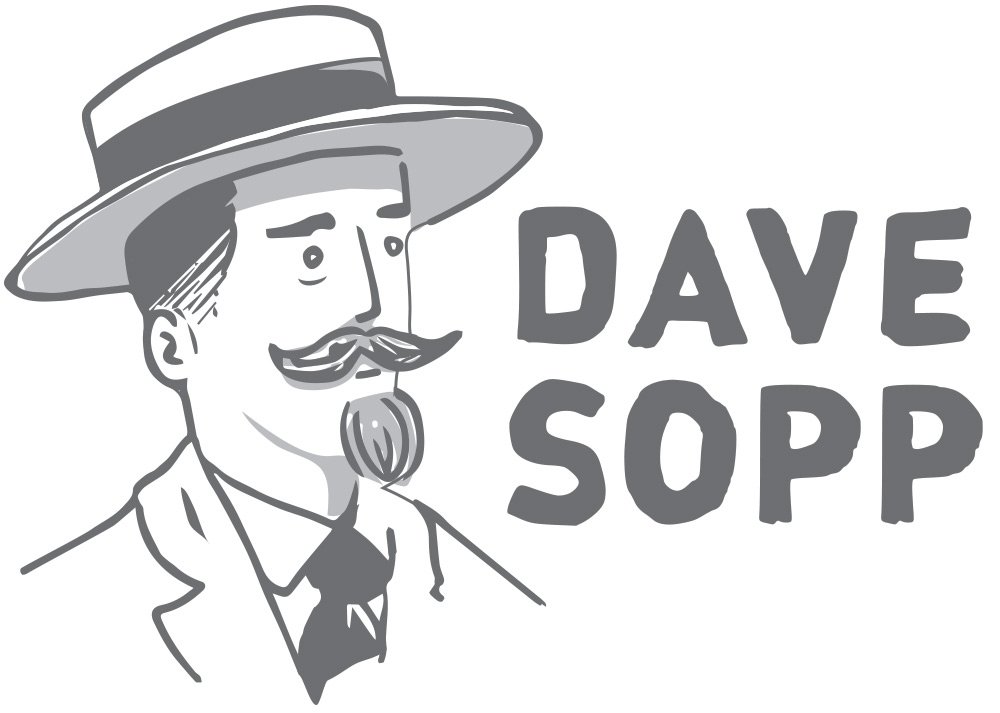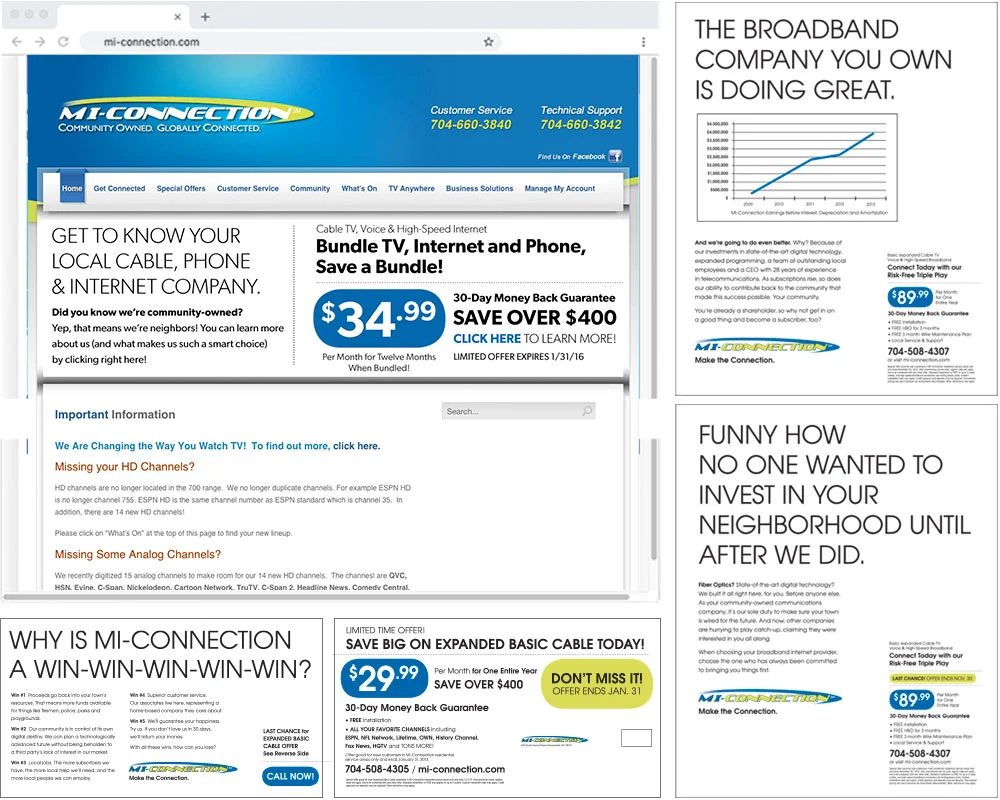Strategy > Branding
Despite the title, this is the funnest (I know, but I made it a word) project I’ve ever worked on. A lot of what makes marketing great (and great marketing) is what happens behind the scenes. Like, how did we involve the client, the CEO, the employees in the process? Or, what obstacles did we have to overcome aside from winning the business? So read on and tell me...what was there not to love about this project from the outset?
FINAL: The first salvo in a campaign designed to convince people to love the communications company they loved to hate.
Three town governments in North Carolina overpaid, substantially ($80,000,000), for a local communications company that was failing in every aspect of the word. The public didn’t get to vote on the action (which they surely would not have done). Nope, the town officials just decided to buy it with taxpayer bonds, and did it. The result was an incredibly bitter, prolonged public comeuppance. The public rallied behind “The government shouldn’t own a communications company!” and before long almost everyone in office was out, out, out. Everyone was replaced by angry electeds who agreed with the angry public that this cable company was bad, bad news. They all wanted out of the deal, but the damage had already been done. They were stuck with a financial burden they couldn’t get out of. That thing was called MI-Connection, with the MI being a lame combination of Mecklenburg and Iredell county initials that nobody, even to this day, can agree on how to pronounce – MY Connection or EM - EYE Connection? Oh, and even if you knew the initials, good luck finding the hyphenated URL. Sad Face Emoji.
But, incredibly, it was kind of an understandable decision to buy the thing. I mean, it’s not like it was done on a whim. Despite the three towns being about 10-20 minutes north of the banking explosion called Charlotte, and populating themselves at an extremely rapid pace, this area was severely under serviced. Heck, if Mooresville, Davidson, and Cornelius didn’t lay fiber and string cable themselves, no one else was motivated to do it. Even though there were three competitors in the market (Windstream, Time Warner, and Dish), these big out-of-town corporations just weren’t investing in this area. Honestly, why should they? So how else could a town (or three) attract residents and businesses so they can grow if they could offer Internet? Before they were (mostly) drummed out of office, the commissioners did one smart thing – they found someone with big telecom experience who could turn the ship around (provided he could stop it from burning even closer to the waterline).
BEFORE: What MI-Connection was putting out there before we cleaned up their act.
In stepped David Auger, CEO. David had incredible experience in telecom, was an ex-Time Warner executive, a marketing aficionado and a lovely man. Sharp as a tack, too. He had MI-Connection lay low for a year, advertising little, assessing the damage, and building a sharp, experienced Board of Directors. Now, here was his (and the town’s, after all they were the owners) core dilemma:
If no one subscribed to MI-Connection’s services (Video, Internet, and Phone), then the whole thing would collapse. So how do you make people love the communications company they LOVE to hate?
My first meeting about MI-Connection was actually with the newly elected Mayor of Mooresville, Miles Atkins. The Town of Mooresville (TOM) was the biggest investor of the three in MI-Connection and Mr. Atkins was the one official who, as commissioner, was a lone voice against buying the business. For a whole year since the purchase, both the press and citizens scorched MI-Connection as an $80,000,000 socialist pariah. But Mayor Atkins had a different perspective. While he opposed the purchase, he could see that we were all stuck with it, no matter what. And by not using it to its fullest advantage, our three towns would not only be shooting themselves in the face, but also lose out on what owning a local communications company could mean to our communities. To his thinking (and it was smart), we all owned this thing – so let’s make the most of it. Mayor Atkins set up a meeting with David Auger and he gave us his perspective. In the year he’d been restructuring, there was actually good news. Lots of it. Mr. Auger was able to shore up the company and even quietly implement some programs to aid the communities who owned the company – free services to non-profits who helped local underprivileged families, free Wi-Fi for underprivileged local students, and more. Also, subscribership was up. The cable company everyone thought was a failure had begun to do better. Way better.
FINAL: We didn’t have to play by any rules but our own. So to convince people our story was worth hearing, we opened up a conversation via all outlets. The website got cleaned up, the ads were bold and in-your face, but communicating SO much better. I devised a template for the direct mail, too. Way more professional using nothing but what was there all along.
FINAL: Some more print and some online that was really fun to write. SUPER click-baity and led you to a landing page that would clear things up pretty quick (and encourage a phone call to MI-Connection).
Obviously, there was a communication problem (amazing how it’s always the culprit, right?) between the communications company and the public. From the outset, officials never conveyed effectively to the public why they were buying this thing. So once it was said and done, the nay-sayers were in control of the narrative. A year of zero self-defense didn’t help matters. What was needed was a little public education. Not subtle, but a giant baseball bat to the noggin.
We called the launch “Straight Talk”, which was exactly what it was. No false posturing, no flamboyance, no marketing speak. We listened to the positive things David and his team had achieved and telegraphed it all straight to the public with full page print, direct mail, local cinema ads, and local online banners every week for 13 weeks. MI-Connection launched out of nowhere with an incredibly tough offense. This local cable company that you, personally, have a stake in is not only beneficial to your life here, but doing rather well. The messaging was raw, compelling, steeped in common sense, and it was all true. And at that breakneck pace, the haters had a hard time trolling our positive, provable messages.
Design-wise, my hands were tied by the existing brand (and its terrible website, name, logo, etc. You can read about how we changed that here), but I was able to rework what existed into a clean, blunt instrument of education that was hard to ignore. This launch campaign ended up being MI-Connection’s steady messaging for 7 years of solid growth. That is, until it became profitable enough to get out from underneath the tainted shadow of the old brand. That’s where the real fun (and success) began.
DAVE SOPP – Creative
Yep, that’s me. I’ve got over 25 years of marketing strategy, graphic design, advertising art direction, and illustration experience. Want to use some of it? Email me at dave@davesopp.com






